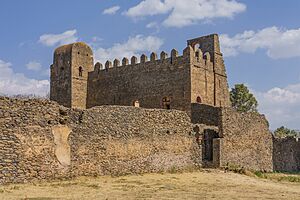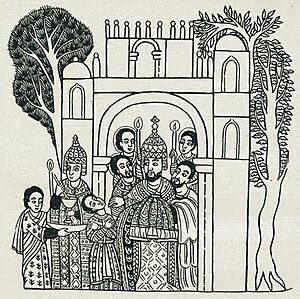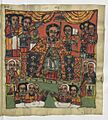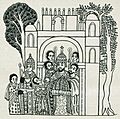Iyasu I facts for kids
Quick facts for kids Iyasu Iኢያሱ ቀዳማዊ |
|||||
|---|---|---|---|---|---|
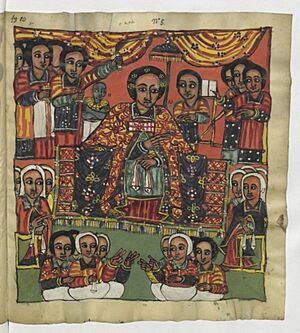
Iyasu I with his court
|
|||||
| Emperor of Ethiopia | |||||
| Reign | 19 July 1682 –13 October 1706 | ||||
| Coronation | 19 July 1682 | ||||
| Predecessor | Yohannes I | ||||
| Successor | Tekle Haymanot I | ||||
| Born | 1654 | ||||
| Died | 13 October 1706 (aged 51–52) | ||||
|
|||||
| Dynasty | House of Solomon | ||||
| Father | Yohannes I | ||||
| Mother | Sabla Wangel | ||||
| Religion | Orthodox Tewahedo | ||||
Iyasu I (also known as Iyasu the Great) was a powerful Emperor of Ethiopia. He ruled from 1682 until 1706. His throne name was Adyam Sagad.
Iyasu I was part of the Solomonic dynasty. This was a long line of rulers in Ethiopia. He is remembered as one of the last "great" emperors of the Gondar period.
He was a skilled military leader. He helped bring back control over areas that had rebelled. He also expanded his empire to the south.
Beyond battles, Iyasu I supported art, building, and books. He tried to unite different groups within Ethiopia's Coptic Church. However, these efforts did not last forever.
Sadly, his own son, Tekle Haymanot I, removed him from power in 1706. Iyasu was later killed by relatives of one of his wives. After his death, the power of the emperors in Ethiopia slowly weakened.
Contents
Early Life and Rise to Power
Family Background
Iyasu I was from the Amhara people. His father was Emperor Yohannes I. His mother was Sabla Wangel.
He had several brothers and sisters. These included Yostos, Tewoflos, Gelawdewos, Amlakawit, and Eleni.
Becoming Emperor
Iyasu became the governor of Semien province in 1676. This happened after his older brother Yostos passed away. He joined his father on a military trip in 1677–1678.
In 1681, Iyasu had a disagreement with his father. He went to live in areas controlled by other groups. There, he met the Kordidas, an Amhara group. They wanted to return to Christianity and be free from Oromo rule. Iyasu promised to help them if he became emperor. Soon after, he made up with his father.
On July 15, 1682, Emperor Yohannes I was very sick. He named Iyasu as his successor. Many important people witnessed this decision.
Emperor Yohannes I died on July 19, 1682. Iyasu then became the new emperor. The crown was placed on his head. Letters were sent to other countries to announce the change.
Leading the Empire
Improving Administration
Iyasu I paid close attention to how the empire was run. He held many meetings to discuss important matters. These meetings covered church issues, state affairs, and new laws. The first big meeting was in 1684 in Gondar.
He also created the Lewa in the late 1600s. This was the first separate armed force with police duties. Their job was to keep peace in towns and on roads.
In 1698, Iyasu I heard that merchants were being unfairly taxed. He took action to stop this. He called the chiefs of Tigray province to question them. This led to lower taxes and tax breaks for small traders. This helped trade grow.
The emperor declared that anyone who tried to tax small merchants would lose their property. They could even face death. He made sure everyone knew where the tax posts were.
Military Campaigns and Conflicts
Building Alliances
Iyasu I made his rule stronger in the south. He allied with two powerful Amhara leaders. These were Demetros of Amhara and Negasi Krestos. They accepted his rule. In return, Iyasu gave them special titles and gifts.
During his reign, some Oromo people started serving in the Imperial court. In 1704, Iyasu I settled some Oromo groups. They accepted Amhara culture and language. They also became Christians. These groups helped protect against attacks from other Oromos.
Many groups suffering from attacks joined Iyasu's government. This included the Kordidas and the Talatas. They hoped the emperor would help them. In 1689, the king of Hadiya people also joined Iyasu. He and his people became Christians. He even married a princess from the emperor's family.
Iyasu I also had soldiers from the Beta Israel and Wellag groups. They served under his command.
Battles and Expeditions
Early in his rule, Iyasu faced an invasion. The Wollo Oromo attacked Amhara province. Iyasu defeated them at Melka Shimfa.
Campaigns Against Wechales and Wollo
In 1684, Iyasu sent scouts to Oromo-controlled areas. They reported back about Wollo Province. Iyasu decided to go there. First, he sent his commander, Ras Anestasyos, to fight the Wechales.
Then, Iyasu attacked the Oromos in Wollo. They were scared and could not fight back well. The emperor took their goods, killed many soldiers, and captured women and cattle.
In 1685, a rebel named Yeshaq Iyasu tried to become emperor. Iyasu quickly stopped this revolt. He captured Yeshaq. Later, he punished the Agaw people who had supported the rebels.
In 1688, Iyasu led a campaign in Dera. He fought a rebellion in the Tulama area. The rebel leader was caught and judged by church officials.
Expedition Against Gisa, Gorsi, and Wambarya
Iyasu also fought against the Shankella people in 1688. He attacked the town of Gisa. He burned it, killed many people, and took slaves and cattle. He then went to Gorsi, another Shankella town, and took more slaves.
Next, he went to Wambarya. This area had resisted three previous rulers. Iyasu fought fiercely there. He killed many enemies and took a lot of treasure. When he crossed the Dura river, the Shankella fled.
Keeping His Promise
In 1689, Iyasu kept the promise he made to the Kordidas. They were suffering under Oromo rule. They had asked him for help when he was a prince. Iyasu marched south to Dara. He took many Tulama Oromos prisoner. Then, he freed the Kordidas. About one hundred thousand of them joined his camp. They sang and danced with joy.
In 1692, the king went on a trip to the Mareb River valley. He fought against the Dubani, or Nara people. The sound of his guns scared them, and they ran away.
In 1704, Emperor Iyasu I campaigned in the kingdom of Ennarea. He faced a civil war there between two people who wanted to be king.
His royal records tell a story about the Ottoman leader of Massawa. This leader tried to tax Iyasu's goods. Iyasu responded by blocking the city. He kept the blockade until the Ottoman leader gave up.
Connecting with Other Countries
Iyasu I worked to build relationships with other Christian kingdoms. He sent Ethiopian representatives to foreign countries. For example, in 1689, an Armenian named Murad led a group to Batavia, Dutch East Indies.
Because of these efforts, Iyasu received a bell from Johannes Camphuys. He was the governor of the Dutch East Indies. Iyasu then gave this bell to the Debre Berhan Selassie Church in Gondar.
These connections also led to a visit from a French doctor, Charles Jacques Poncet. He came to Ethiopia to treat Iyasu and one of his sons. Poncet arrived in Gondar in 1699 and stayed for over a year. He later wrote about his visit.
Poncet described Iyasu the Great as a great leader. He said Iyasu was about 41 years old and had many children. He called Iyasu "the most handsome man" he had seen in Ethiopia. Poncet noted that Iyasu loved art and science. But his main passion was war. He was brave in battles and always led his troops. Iyasu also loved justice and treated his people fairly. He was respected and loved by his subjects.
Death of Iyasu I
A Sad Loss
In 1705, Iyasu was fighting in Ennarea. He heard that his favorite wife, Kedeste Kristos, was very sick. He stopped his campaign and rushed back to Gojjam. But when he arrived, she had already died.
Iyasu was heartbroken. He went to an island in Lake Tana to mourn.
Iyasu's Assassination
In 1706, some officials, supported by another wife named Malakotawit, said Iyasu had given up his throne. They crowned his son, Tekle Haymanot I, as the new emperor.
Some stories say Iyasu did not mean to give up his power. He started to march from Lake Tana to Gondar to protest. But during this time, he became sick. He was then killed on the orders of Tekle Haymanot. His maternal uncles, Dermen and Pawlos, carried out the act.
Aftermath of His Death
Iyasu's death caused great sadness in the capital city. The priests of Debre Berhan Selassie church openly showed his gifts to them. They mourned him for a month.
He was buried on Mitraha Island. It is said that his body was placed among his ancestors. Later, his brother Tewoflos became emperor. He started the process to make Iyasu a saint.
Legacy and Family
Impact on the Kingdom
After Iyasu I was killed, the power of the emperors in Gondar slowly declined. There were many changes in leadership. About twenty-five emperors were removed from power in the next 150 years. This continued until Tewodros II came to power in the mid-1800s.
His Family
Wives and Concubines
In 1683, Iyasu married Walatta Seyon. She was from Hamasien, in modern-day Eritrea. They had a son and a daughter. Walatta Seyon died in 1693. She was his only official wife.
Iyasu had many children with other women, known as concubines. Four of his sons later became emperors. One concubine, Malakotawit, helped plan his removal and later his death. Emperor Tewoflos punished everyone involved in the plot against Iyasu. On October 13, 1708, Malakotawit and her brothers were executed.
Iyasu's favorite concubine was Qeddesta Krestos. They had five children together. Qeddesta was from a place near Lake Tana. The cause of her death in 1705 is debated. But her death greatly affected Iyasu. It led to the events that ended his reign and life.
Another concubine mentioned was Maryamawit. She was the mother of Emperor Bakaffa.
His Children
- Fasilades was Iyasu's first son with his wife, Walatta Seyon. He was supposed to be the next emperor. But he died young in 1700.
- Walatta Rufael was his daughter with Walatta Seyon.
- Emperor Tekle Haymanot I was Iyasu's son by his concubine, Malakotawit. She encouraged him to take power from his father. Tekle Haymanot's short rule ended in 1708 when he was killed.
- Emperor Dawit III was his son by Qeddesta Krestos. Iyasu seemed to favor Dawit later in life. Dawit was released from the royal prison at Wehni around 1698-1699. He ruled as Emperor from 1716 to 1721.
- Emperor Yohannes II was also his son by Qeddesta Krestos. Yohannes briefly became emperor in 1769.
- Yonathan was his third son by Qeddesta Krestos.
- Emperor Bakaffa was the son of Maryamawit. Bakaffa became emperor after his half-brother Dawit. He ruled from 1721 to 1730.
- Yostos was Iyasu's seventh son. His mother is not known. His descendant, Iyasu IV, briefly became emperor in the 1830s.
- Walatta Selassie was Iyasu's second daughter. Her mother is unknown.
- Walatta Israel was Iyasu's third daughter. Her mother is unknown. Her son, Gerazmach Iyasu, married Empress Mentewab.
Images for kids


